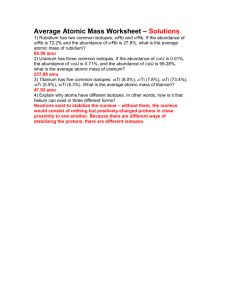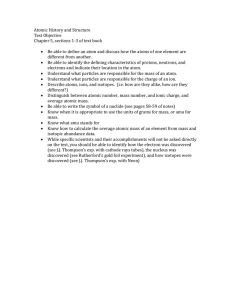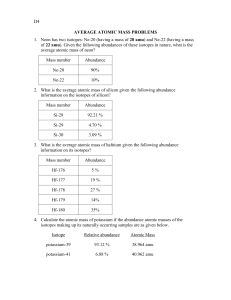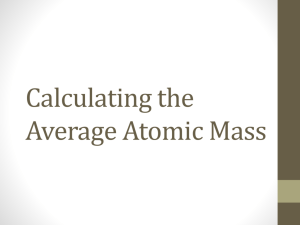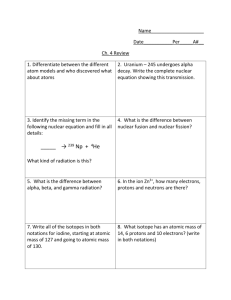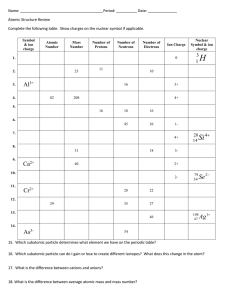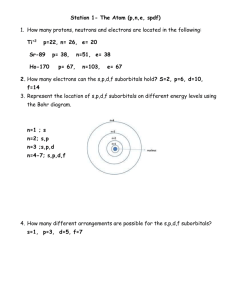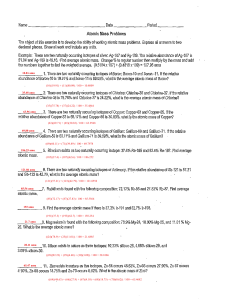2 Atoms and Elements
advertisement
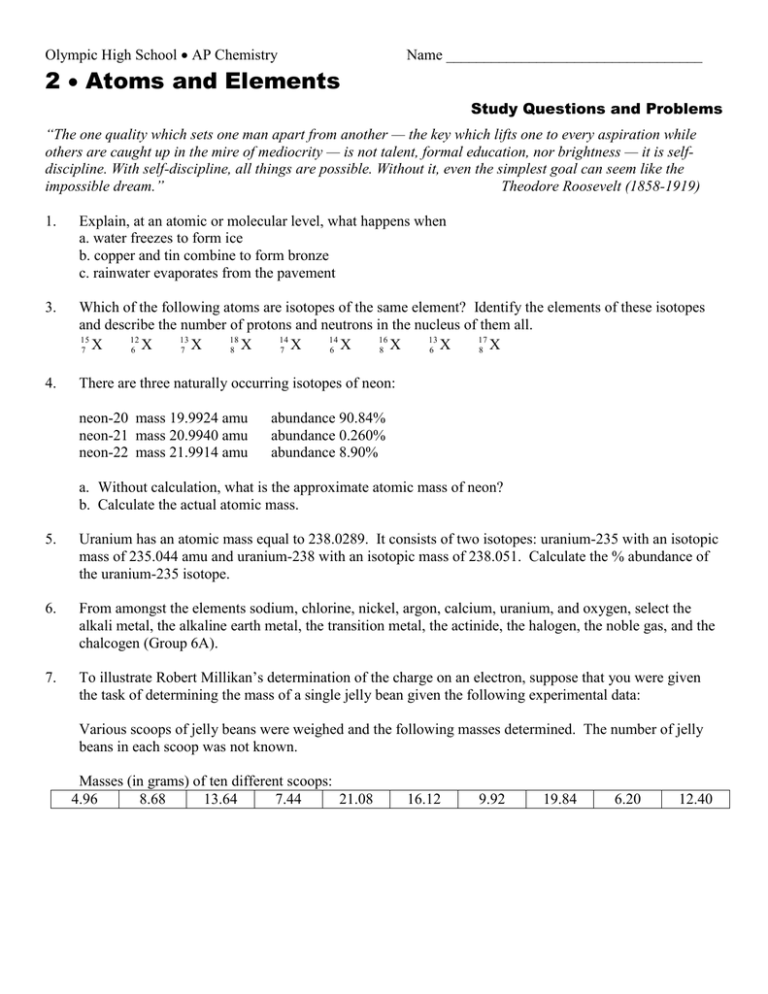
Olympic High School AP Chemistry Name __________________________________ 2 Atoms and Elements Study Questions and Problems “The one quality which sets one man apart from another — the key which lifts one to every aspiration while others are caught up in the mire of mediocrity — is not talent, formal education, nor brightness — it is selfdiscipline. With self-discipline, all things are possible. Without it, even the simplest goal can seem like the impossible dream.” Theodore Roosevelt (1858-1919) 1. Explain, at an atomic or molecular level, what happens when a. water freezes to form ice b. copper and tin combine to form bronze c. rainwater evaporates from the pavement 3. Which of the following atoms are isotopes of the same element? Identify the elements of these isotopes and describe the number of protons and neutrons in the nucleus of them all. 15 12 13 18 14 14 16 13 17 7 X 6 X 7 X 8 X 7 X 6 X 8 X 6 X 8 X 4. There are three naturally occurring isotopes of neon: neon-20 mass 19.9924 amu neon-21 mass 20.9940 amu neon-22 mass 21.9914 amu abundance 90.84% abundance 0.260% abundance 8.90% a. Without calculation, what is the approximate atomic mass of neon? b. Calculate the actual atomic mass. 5. Uranium has an atomic mass equal to 238.0289. It consists of two isotopes: uranium-235 with an isotopic mass of 235.044 amu and uranium-238 with an isotopic mass of 238.051. Calculate the % abundance of the uranium-235 isotope. 6. From amongst the elements sodium, chlorine, nickel, argon, calcium, uranium, and oxygen, select the alkali metal, the alkaline earth metal, the transition metal, the actinide, the halogen, the noble gas, and the chalcogen (Group 6A). 7. To illustrate Robert Millikan’s determination of the charge on an electron, suppose that you were given the task of determining the mass of a single jelly bean given the following experimental data: Various scoops of jelly beans were weighed and the following masses determined. The number of jelly beans in each scoop was not known. Masses (in grams) of ten different scoops: 4.96 8.68 13.64 7.44 21.08 16.12 9.92 19.84 6.20 12.40 8. 9. Reorder this list to match the name of the scientist with his or her contribution to our understanding of the nature of matter: J.J. Thompson James Chadwick Robert Millikan Henry Moseley Michael Faraday Dmitri Mendeleev John Dalton Henri Becquerel Democritus _______________ _______________ _______________ _______________ _______________ _______________ _______________ _______________ _______________ developed the idea of the atomic nature of matter established the law of conservation of matter characterized positive and negative electrical charges suggested that atoms could disintegrate experimented with electrolysis proved the existence of the electron developed the idea of a nuclear atom discovered the neutron developed the first periodic table of elements Joseph Proust Antoine Lavoisier Ernest Rutherford Marie Curie Benjamin Franklin _______________ _______________ _______________ _______________ _______________ showed that periodicity depended upon atomic number formulated the laws of constant composition determined the charge on a single electron revived the atomic theory discovered radioactivity Identify the following elements: a. The most abundant metal in the earth’s crust b. Combined with chlorine, it produces a compound essential to life. c. A metal that occurs in vast limestone deposits and combines with oxygen to form an oxide with a formula MO. d. The transition element at the center of hemoglobin. e. Used in smoke detectors and named for the United States. f. A component of washing powder mined in Death Valley. g. The basis for the compounds that make up all living things. h. Primary constituent of pencil lead. i. The last element in the Periodic Table that is not radioactive. j. Exists as X4 molecules. k. The element named after the sun, where it was first detected.

